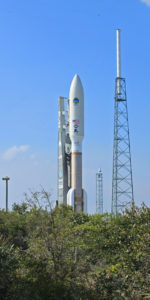
CAPE CANAVERAL, Fla. – The skies above Cape Canaveral Air Force Station were thankfully clear of both high winds and threatening clouds before United Launch Alliance (ULA) sent an Atlas V 551 rocket thundering into the heavens. The U.S. Navy’s Mobile User Objective System-1 (MUOS-1) satellite roared to orbit a little over a week later than originally planned. MUOS-1 will serve to improve communications for U.S. service personnel on the move.
The satellite was launched atop a version of the Atlas V – that has only been used to launch NASA’s planetary missions previously. The 551 configuration is the same version that sent the New Horizons mission to Pluto and the Kuiper belt, the Juno mission to Jupiter and the Mars Science Laboratory rover Curiosity to Mars. The reason why the 551 was used to launch the MUOS-1 – is the satellite’s size. MUOS-1 is big. Launch occurred at 5:15 p.m. EST from Cape Canaveral Air Force Station’s Space Launch Complex-41 (SLC-41).

The Atlas 5 rocket carried the first satellite in the U.S. Navy’s planned five-satellite MUOS constellation. These satellites will be comprised of four working satellites and one on-orbit spare. Lockheed Martin’s contract for the MUOS constellation is valued at $4.3 billion.
The MUOS system is an Ultra High Frequency (UHF) system which is being placed in orbit to replace the aging UHF Follow-On (more commonly known as UFO) constellation. Aerial, naval and ground-based vehicles are all set to receive improved communications when the MUOS system goes online.
“ULA is honored to serve with our mission partners in the preparation and launch of this important mission for the U.S. Navy and for our U.S. Air Force customer,” said Jim Sponnick, ULA vice president, Mission Operations. “This integrated team is singularly focused on ensuring that these critical MUOS satellites are safely delivered, providing vital communications capability to the women and men protecting our freedom around the world.”

This constellation of satellites will provide military personnel with approximately 10 times greater communications capabilities beyond what currently-existing systems offer. Utilizing 3G communications, MUOS-1 is hoped to give near-simultaneous voice, video and data transmission capabilities to warfighters on the move.
The launch had been originally scheduled to take place on Thursday Feb. 16, but high upper-level winds continuously pushed back the launch time until the launch window closed. The following day ended with the same results. The Atlas V had its fuel removed and both the rocket and its payload, safely ensconced in its fairing, were moved back into the adjacent Vertical Integration Facility (VIF).

This mission marks the 200th flight of the Centaur upper-stage that is used on the Atlas launch vehicle. Atlas itself is comprised of a variety of components that hail from across the nation – and the world. Although most of the rocket’s components are produced in the U.S. The engines on the launch vehicle’s first stage are actually produced by NPO Energomash – in Russia. The fairing, which serves to protect the satellite through launch is produced by RUAG Space in Switzerland.
The initial launch attempt would have occurred just a few days before John Glenn’s historic mission in 1962. For his part, Senator Glenn feels that Atlas has provided much to the nation over the last half-century.
“The program has come a long way since 50 years ago when I launched on an Atlas launch vehicle,” Glenn said. “I’m just glad the latest version is still doing such important work for our nation.”





